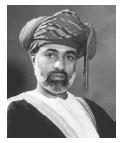OMAN
Qaboos bin Said al Said
Sultan

(pronounced "kah-BUSS BIN sigh-EED AL sigh-EED")
"Our country in the past was famous and strong. If we work in unity and cooperation we will regenerate that glorious past and we will take a respectable place in the world."
Known as Muscat and Oman prior to August 1970, the Sultanate of Oman occupies the extreme east and southeast of the Arabian Peninsula. It is surrounded on the northwest by the United Arab Emirates (UAE), on the west by Saudi Arabia, and on the extreme southwest by Yemen. On the tip of the Musandam Peninsula lies a detached portion of Oman, separated from the rest of the country by the UAE, which extends into the Strait of Hormuz. Oman has a coastline of about 2,092 km (1,301 mi) on the Indian Ocean, and its total area is about 212,460 sq km (82,031 sq mi). In 1999, the Omani government settled its border disputes with UAE.
Oman's first census of population was conducted in 1993; the next census was scheduled for 2003. Oman's population was estimated at 2.7 million in 2002, over 500,000 of whom are expatriate workers. Omanis constitute about 45% of the total labor force. The majority of the population are Ibadi Muslims, a small religious sect that is the only surviving offshoot of an early radical sect, the Khawarij. Around 25% are Sunni Muslims. Ethnically, the Omani population is predominately Arab. Small communities of Iranians, Baluchis, Indians, Pakistanis, and East Africans also inhabit the country. While Arabic is the official language, Persian, English, Urdu, and several other South Asian dialects are also spoken. The Oman riyal is the currency of the country. Oman's gross domestic product (GDP) in 2001 was approximately US $21.5 billion. Oman's economy is largely based on petroleum exports. Oman's oil reserves, however, and production are not as extensive as UAE's or Kuwait's and, therefore, it has had to rely on grants from the Gulf Cooperation Council for its development projects.
Oman's economic growth has been concentrated on coastal urban areas while the interior has remained poor and undeveloped. Although 70% of the country's population is rural and engaged in traditional farming, herding (cattle breeding), or fishing, Oman has to import most foodstuff. It exports dates, nuts, limes, and fish. Oman's main trade partners are the Middle Eastern countries, Western Europe, Japan, and the United States.
ADDRESS
The Palace
Muscat
Sultanate of Oman
Comment about this article, ask questions, or add new information about this topic: